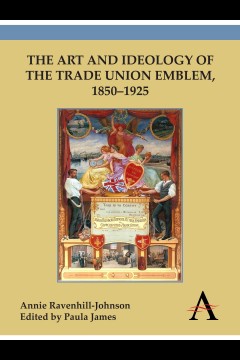The Art and Ideology of the Trade Union Emblem, 1850–1925
By Annie Ravenhill-Johnson
Edited by Paula James
- About This Book
- Reviews
- Author Information
- Series
- Table of Contents
- Links
- Podcasts
About This Book
‘The Art and Ideology of the Trade Union Emblem, 1850–1925’ is a ground-breaking book that considers trade union emblems and banners as art objects in their own right. It studies their commissioning, their designers and the social conditions and gender relations that they knowingly or unwittingly reveal. The volume celebrates working-class culture and shows how it could be both innovative and derivative. Annie Ravenhill-Johnson’s exploration of the artistry of the emblems – the art of and for the toiling masses – sets these images of labour in their historical, cultural and ideological context. Her introductory chapter explores the re-signification of Greco-Roman, medieval and Renaissance architecture, figures and symbols in the emblem tradition, and analyses how these images served as representations of the developing self-awareness of the growing industrial workforces during the nineteenth and early twentieth centuries. The emblems of organized labour followed the traditions set out by Freemasonry and Friendly Societies that had adopted and adapted classical, biblical and medieval depictions of crafts and craftsmen to illustrate the antiquity of their trade and to lend solemnity and legitimacy to the tradition of forming associations for protection and benefits. Renaissance art, architecture and sculpture, the conventions of landscape painting and the more prestigious genres of mythical and biblical subjects all provided settings and structures that sanitized working conditions and idealized the workers themselves.
Reviews
‘“The Art and Ideology of the Trade Union Emblem, 1850–1925” is a totally engaging read. It offers a truly scholarly approach to the reading of trade union banners, drawing upon art historical method and a full understanding of the classical references which we need to understand the symbolic import of the banners. But of equal importance is the contemporary historical reference that the author and editor bring to their analysis, showing how trade unionists could both co-opt classicism and high art in the service of political and social struggle to transform the lot of their members. This is a bold tale, well told, and visually compelling.’ —Professor Nick Stanley, Honorary Research Fellow, The British Museum
‘Combining art history and classics, “Art and Ideology” is an important new source for museum curators researching the trade union and fraternal regalia found in many collections, as well as being a model case study for scholars of many disciplines in using material culture as academic evidence.’ —Dr Nicholas Mansfield, Senior Research Fellow in History at the School of Education and Social Science, University of Central Lancashire
Author Information
Dr Annie Ravenhill-Johnson, born 1942, is from Jersey in the Channel Islands. She gained her BA (Hons) from the University of Warwick, and holds a postgraduate diploma with distinction and an MA with distinction in the history of art and design from the Birmingham Institute of Art and Design (University of Central England in Birmingham), where she also studied for her DPhil.
Paula James was born in Southampton in 1950. She holds a PhD in Latin from the University of Southampton, and is a senior lecturer with the Classical Studies Department at the Open University, having held the post since 1993. She is also a staff tutor in the Arts Faculty of the Open University’s South East Region.
Series
Table of Contents
Preface; Acknowledgements; About the Authors; List of Plates; Introduction; Chapter 1: The Genre; Chapter 2: The Emblem within the Emblem; Chapter 3: Depicting the Worker; Chapter 4: James Sharples and His Legacy; Chapter 5: The Development of the Architecture of the Emblem; Chapter 6: Arthur John Waudby and the Symbols of Freemasonry; Chapter 7: Men, Myths and Machines; Chapter 8: The Classical Woman; Chapter 9: Walter Crane; Chapter 10: The Art of Copying; Conclusion: Reprise and Review; Notes; Glossary; Bibliography; Index
Links
Stay Updated
Information
Latest Tweets



